PORTABLE MICROSCOPE
MAKER:ANDREW PRITCHARD (ATTRIB)
MODEL:
c.1838-1846
SIGNED AND RETAILED BY: A. Dodd, 36 Glassford St, Glasgow
AUTHOR, & COLLECTION OF: Jurriaan de Groot
Editors: Barry Sobel, Joe Zeligs
Please Click on Any Picture for a Larger Version
DESCRIPTION:
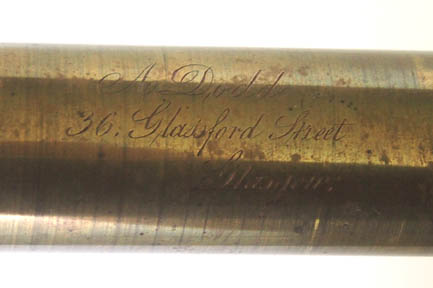
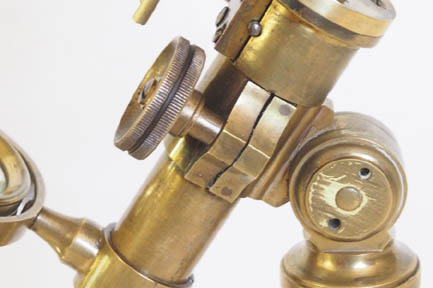 This is an example of a more compact Pritchard microscope, which is signed on the tube:
This is an example of a more compact Pritchard microscope, which is signed on the tube: A. Dodd, 36 Glassford St, Glasgow
.
The microscope is supported by a heavy circular brass base 95 mm in diameter and 19 mm thick. From this arises a central 130 mm
brass pillar which extends into a compass joint, an extension of which forms a clamping ring encircling the limb. This piece serves as a clamp that when tightened with a knurled knob, fixes the limb in the chosen position. This arrangement, characteristic of Pritchard instruments, allows for rotation of the entire body of the microscope through 90 degrees in both directions, for use with a vial holder used on top of, or in lieu of the stage.
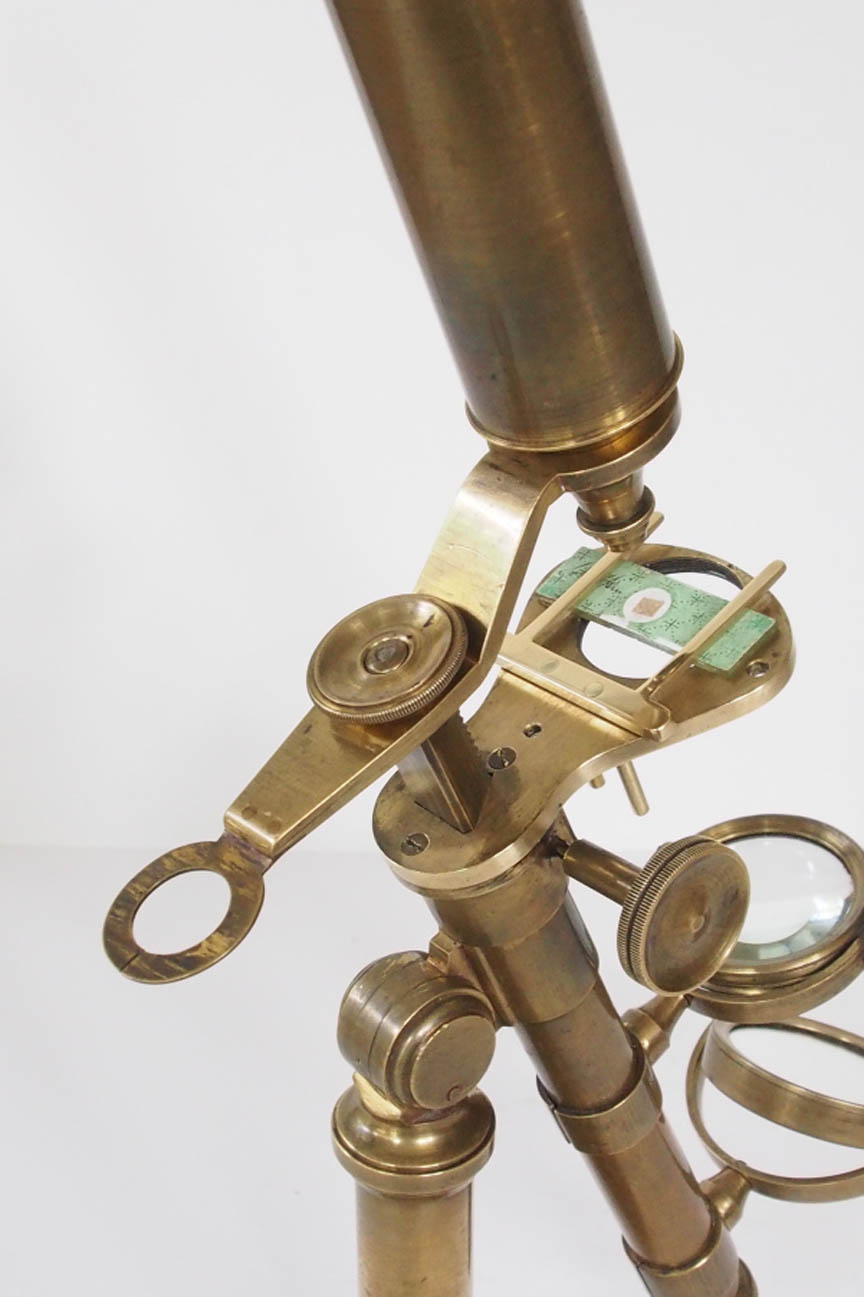
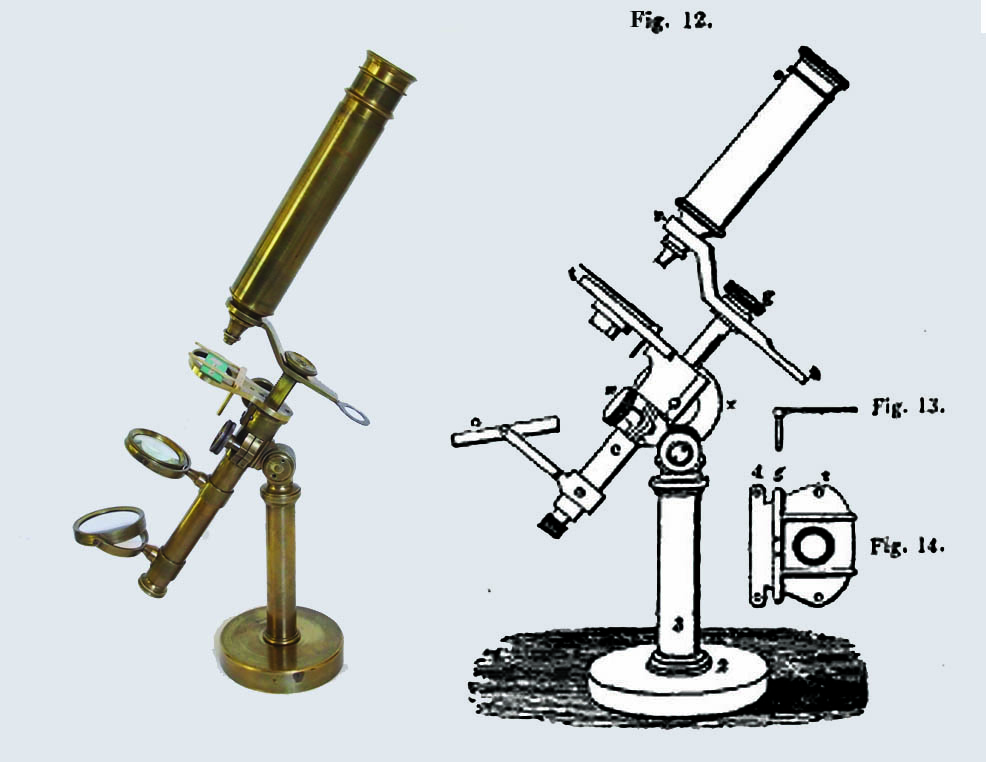 The stage has the earlier pear-shape as first described as an illustration in The Natural History of the Animalcules (1834 and 1845 editions) and features a fork-shaped plate of brass affixed to the stage with two pins
The stage has the earlier pear-shape as first described as an illustration in The Natural History of the Animalcules (1834 and 1845 editions) and features a fork-shaped plate of brass affixed to the stage with two pins to retain the slider firmly on the stage when the instrument is inclined
.
The tailpiece is an extension of the limb and on this example carries a gimballed substage condenser lens and a double-sided flat/concave mirror.
Both are carried on sleeves, which can be slid up and down for adjustment of illumination. The upper end of the limb carries a triangular bar with rack-and-pinion coarse adjustment which is operated by a single knurled knob placed on the right-hand side. There is no fine adjustment.
The horizontal arm is affixed to the bar with a knurled knob, and curves up on one side towards a threaded aperture which receives the 150 mm long brass body tube, in which slides a draw tube, allowing for a maximum mechanical tube length of 270 mm. This has an internal diameter of 31 mm to take the
eye pieces. The other side of the arm is tapered and ends in a thin ring with a central aperture of 15.8 mm to fit the single lenses for use as a simple
microscope. The instrument stands about 450 mm tall when in use.
ACCESSORIES:
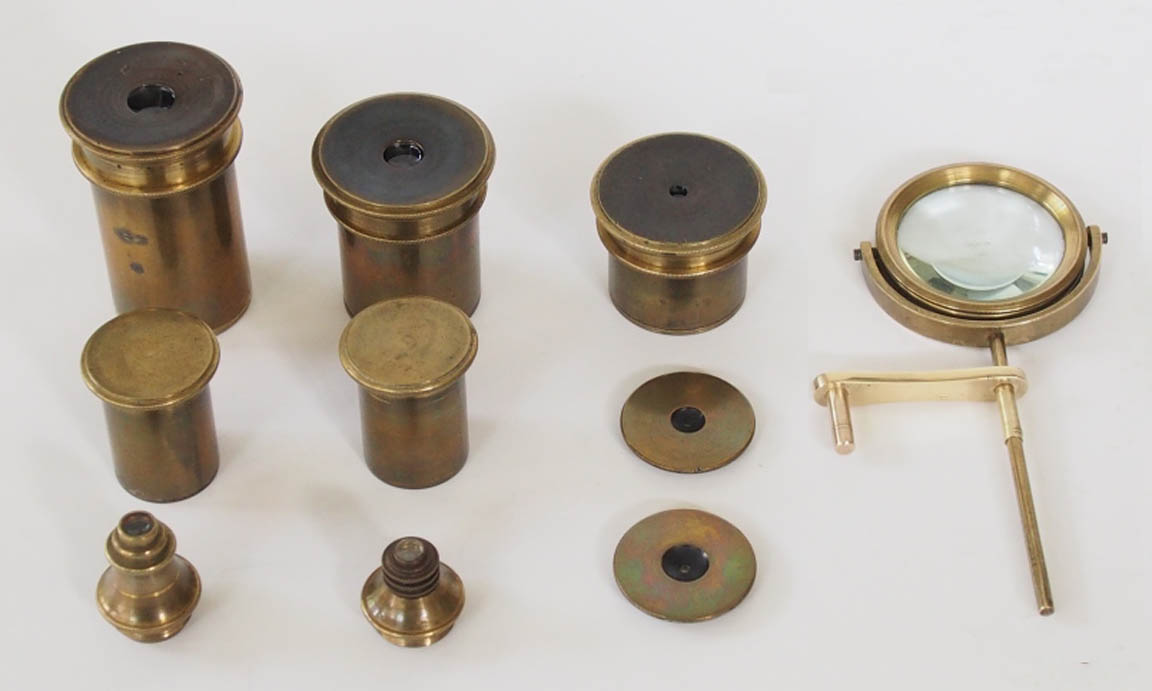
EYEPIECES
Three original eyepieces are present with approximate magnifications of 5X, 8X, and 12X. These have screw-on eye caps and are of the Huygenian type.
OBJECTIVES
There are two early achromatic objectives with a pre-RMS thread of 17 mm. The lower power is made up out of two achromatic doublets spaced 19 mm apart,
whereas the more powerful objective consists of three French buttons screwed in series. Both are housed in brass cans without inscription.
OPTICAL DATA OBTAINED WITH STAGE MICROMETER AND CHESHIRE APERTOMETER:
| OBJECTIVE |
N.A. |
MAGNFICATION WITH EYEPIECES |
| 5X |
8X |
12X |
| Low Power |
0.12 |
56 |
80 |
122 |
| High Power |
0.25 |
125 |
166 |
280 |
SINGLE LENSES
There are two non-achromatic single lenses, mounted in circular flat eye cups which are a push-fit within the ring at one end of the double arm.
These give magnifications of approximately x25 and x50 when used as a simple microscope.
STAGE ACCESSORIES
There is a gimballed stage bullseye condenser for use with opaque objects carried on an arm which fits into a hole on the top of the stage, but no other accessories.
CASE
The microscope is stored in its original veneered mahogany case measuring 275 mm (W)x 205 mm (D) x 110 mm (H). There are recesses for storage of the objectives, eye pieces, single lenses, as well as the stage bullseye condenser.
CONDITION
The microscope retains little of its original lacquer. Some time during the later end of the 19th century a previous owner had fitted a larger square stage with sliding bar, affixed to the top of the original pear-shaped stage with three screws. This superimposed stage has been removed, revealing the original stage underneath. In all likelihood this superimposed stage necessitated enlargement of the original stage's central aperture. The current owner has re-created the fork-shaped brass slide clamp to match the configuration of the original stage.
HISTORY OF THE :
This microscope probably originated from Andrew Pritchard's workshop, or was made by someone working for him, and was sold to the retail trade, and
as such is not signed by him. According to Gloria Clifton, Andrew Dodd was established as an optician in Glasgow, Scotland, between 1837-1847, and traded
from the 36 Glassford address between 1838-1846, in between which years this microscope was probably retailed by him. The link with Pritchard becomes stronger,
as this microscope exactly matches the description of a similar model in the amended 1838 edition of Pritchard's Microscopic Illustrations....,
which also has the circular base, pear-shaped stage, and inclining limb. Pritchard himself writes of this microscope: The stand of this instrument
appears not to be different from those of the old-fashioned compound microscope, except in having a simple round foot, which is here adopted to save expense.
Like them it has a joint for inclining the instrument at any required angle; but it has besides, this novelty, which, although simple, is of great importance,
viz. a capability of permitting the stem to be turned around on its axis, so as to allow a glass vessel, or slider accommodated for animated creatures or
plants, to be retained in an upright position, and their contents investigated without having recourse to stoppers and corks.....
.
Pritchard also made both larger more complex microscopes such as the Achromatic Engiscope
and smaller and less complex simple microscope which he described as his New Pocket Microscope
in his book of 1832, The Microscopic Cabinet.... For more information about Pritchard and his microscopes, please see the article on Brian Stevenson's site, microscopist.net.
Shown below is a comparison of four Pritchard microscopes, with the New Pocket Microscope
of about 1837 on the left and the largest, the Massive
Achromatic Engiscope
of about 1854 on the far right. To the right of the Portable model featured above, on this page, is the Aplanatic Engiscope
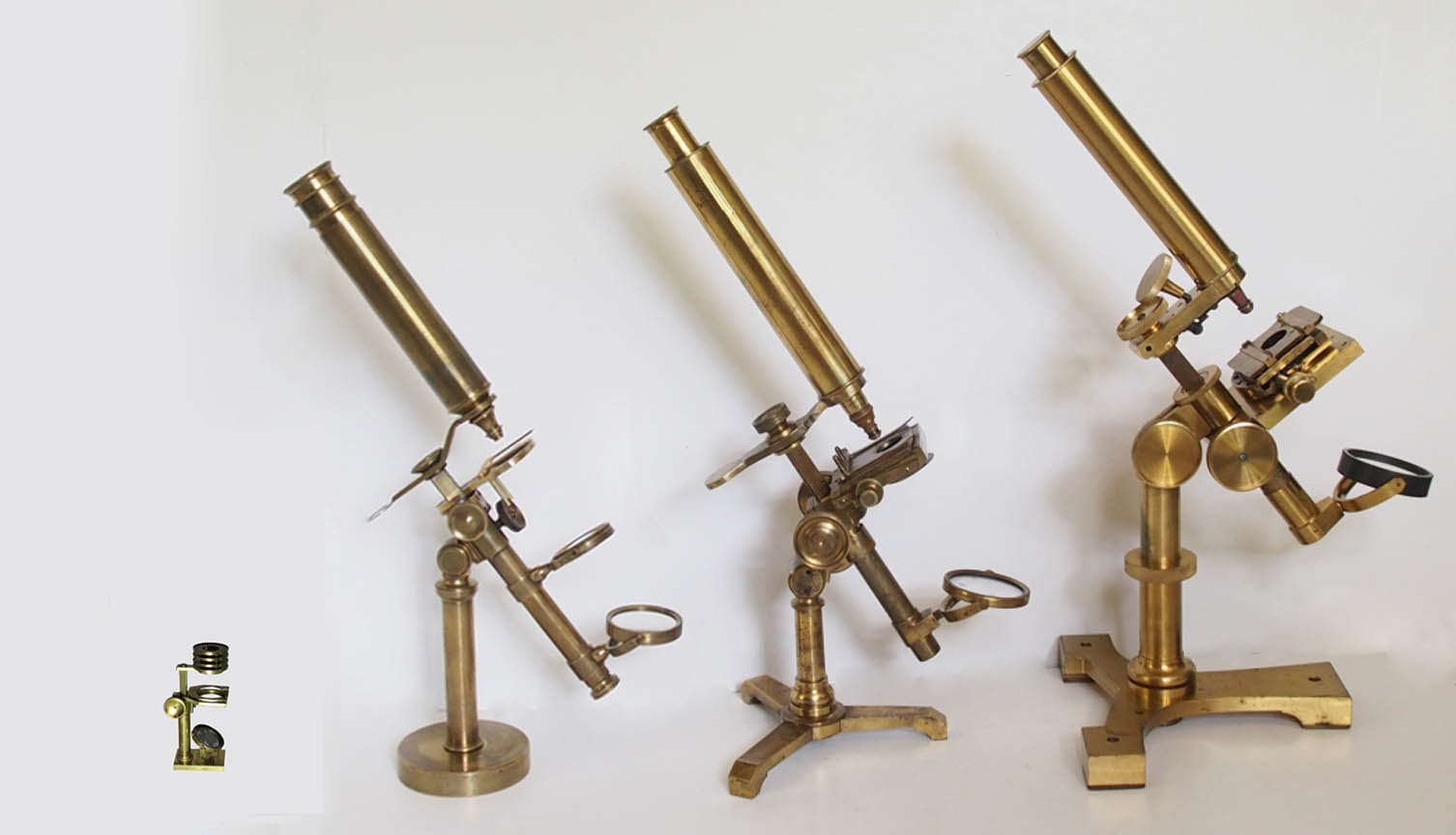

 This is an example of a more compact Pritchard microscope, which is signed on the tube:
This is an example of a more compact Pritchard microscope, which is signed on the tube: 
 The stage has the earlier pear-shape as first described as an illustration in The Natural History of the Animalcules (1834 and 1845 editions) and features a fork-shaped plate of brass affixed to the stage with two pins
The stage has the earlier pear-shape as first described as an illustration in The Natural History of the Animalcules (1834 and 1845 editions) and features a fork-shaped plate of brass affixed to the stage with two pins 
